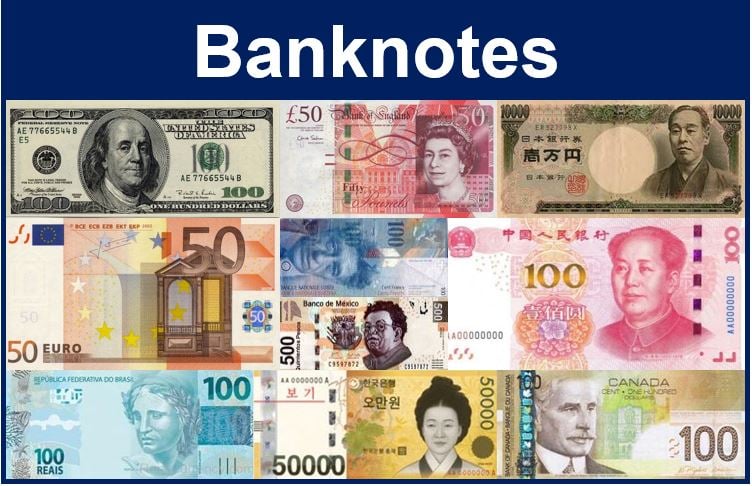Banknote – definition and meaning
A banknote means paper money. A $20 bill is a banknote and a ₤20 note is a banknote. North Americans refer to a banknote as a bill. Britons, Irish people, and Australians, on the other hand, say a note. Therefore, an American will say “I have a $20 bill,” while a Briton would say “I have a ₤20 note.”
Central banks issue banknotes. The Bank of England says it has been issuing banknotes for more than 300 years.
According to the US Treasury, American banknotes are available in bills of $1, $2, $5, $10, $20, $50 and $100. The Bank of England says it issues four different denominations – ₤5, ₤10, ₤20 and ₤50.

Central banks and banknotes
The Board of Governors of the US Federal Reserve System (Fed) has a wide range of responsibilities related to American banknotes. Not only do they have to make sure supplies are adequate, but also protect confidence in the US dollar.
The Fed says on its website:
“The 12 regional Federal Reserve Banks, through their network of Districts and branches throughout the country, distribute Federal Reserve notes to the public through depository institutions. Reserve Banks process notes on high-speed sorting machines that check to ensure that they are genuine and fit for recirculation.”
According to Oxford Dictionaries, a banknote is:
“A piece of paper money, constituting a central bank’s promissory note to pay a stated sum to the bearer on demand.”
For hundreds of years, we have been using paper to make banknotes. Recently, however, many central banks have been switching to printing on polymer. Polymer is a flexible and thin plastic film that resists washing machine cycles. Polymer also has a much longer life than paper.
The banknote – early history
Historians believe paper money first appeared during the Tang Dynasty in China in the 7th century. However, paper money did not emerge in a big way until the Song Dynasty in the 11th century.
Banknote usage subsequently spread throughout the Mongol Empire. In the 13th century, European explorers including Marco Polo and William of Rubruck brought back the paper money concept from the Far East.
In the early 1800s, Napoleon issued paper banknotes. Paper money originated in two forms:
- Bills which the authorities issued with a promise to convert at a specified date.
- Drafts, which are receipts for a value held on account.
The predecessor of our current regular banknotes emerged in medieval Italy and Flanders. Transporting huge amounts of money was both impractical and dangerous. So money traders started issuing promissory notes.
Initially, individual people issued the promissory notes. However, they later became written orders to pay a specific amount to those who had them in their possession.
The banknote – recent history
Soon after its birth in 1694, the Bank of England (BoE) started to issue notes in return for deposits. The notes promised to pay the bearer a sum on demand. Anybody who presented these notes could redeem them at the Bank of England for gold or coinage.
Initially, the cashier wrote and signed the notes on the BoE’s paper. After 1696, the BoE decided that the minimum value of a banknote would be £50. Most people’s annual income was less than £20. Therefore, the vast majority of the population never handled banknotes.
There was a gradual move during the 18th century toward fixed denomination banknotes. Eventually, the central bank started printing some of the text. By 1853, the first fully-printed notes appeared.

The Bank of England opted to keep the name of the Chief Cashier as the payee on banknotes. This practice continues today in the UK. In the US, on the other hand, the Secretary to the Treasury and the Treasurer sign the bills.
Many banknotes are fake
According to studies, 100 in every 1,000,000 US dollars are counterfeit banknotes. Fifty in every 1,000,000 euros, 300 in every 1,000,000 pounds, and ten in every 1,000,000 Swiss francs are fakes.
The Fed says the best way to check a banknote is to examine its security features. For example, the banknote’s security thread and watermark are extremely difficult to copy perfectly.
The Fed adds that detection pens are not 100% accurate and may give false results.
Traders and consumers should know what the security features of their banknotes are. If they end up with a fake note, they will lose that money.
It is illegal to pass on counterfeit currency. Even if you did not create a fake banknote, you are breaking the law if you pass it on.
The Fed says the following on its website:
“If you live in the United States and you think you’ve received a counterfeit note, immediately notify the local police. Try to remember the physical characteristics of the person who passed the suspect counterfeit, and if possible write down the person’s license plate number and vehicle description.”
“Store the suspect counterfeit apart from genuine currency and release it as soon as possible to law enforcement authorities.”
Detecting counterfeit banknotes
The banking system detects most fake banknotes during the sorting process for re-circulation. Retailers and members of the public also hand over some of them to the police or banks. Additionally, there are police raids, which are responsible for the discovery of many fake banknotes.
In most advanced economies, people detect counterfeits rapidly. In fact, most of them are out of the system after just one single use.
The BoE says that about 430,000 counterfeit banknotes were taken out of circulation in 2014. In that year, they had a face value of £8.1 million.
The central bank added “This is just a tiny proportion of the genuine banknotes in circulation; an average over 3 billion with a face value exceeding £61 billion.”
Video – the life of a banknote
This Bank of Canada video explains how banknotes are made.

